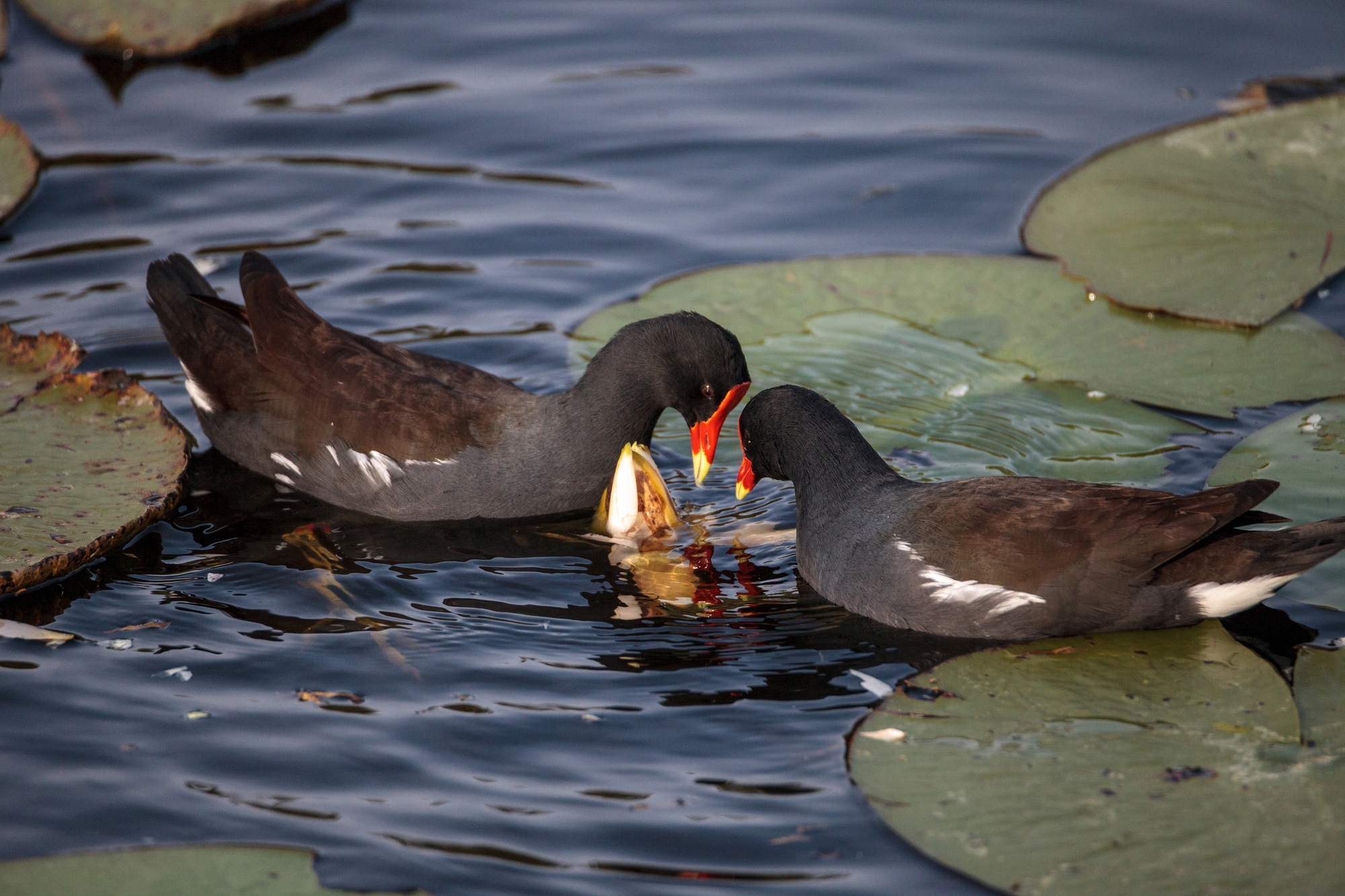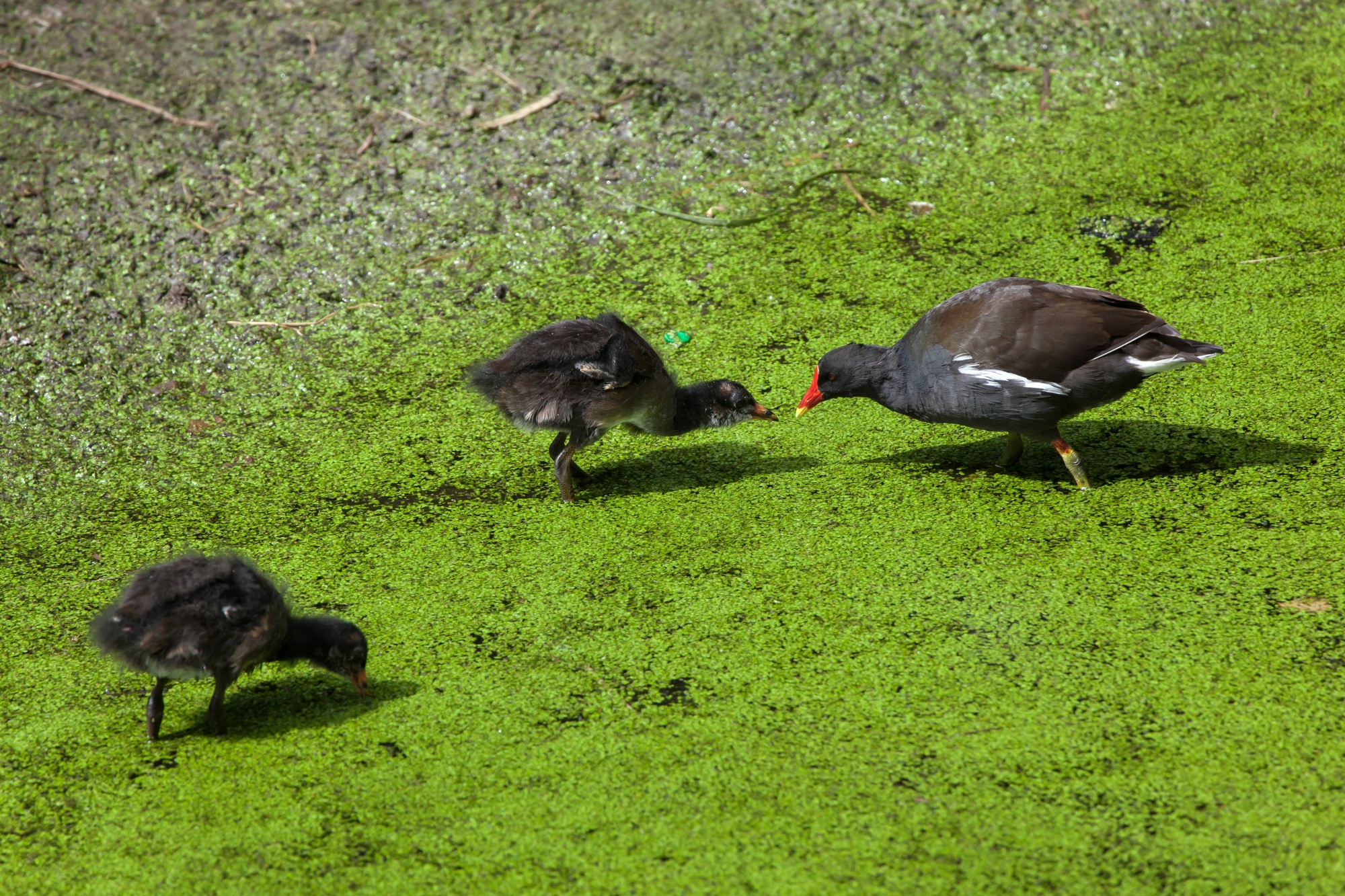The moorhen (gallinula chloropus) is a water bird that is a member of the rail family. It is the only living bird species in its genus. It has also been called the American coot, common moorhen, swamp chicken, and marsh hen.
The moorhen has many different names in different places. It can be called the coot (Fulica atra) or moorhen in North America and Europe, respectively, while it’s known as the Indian moorhen to differentiate from its African relative.
Moorhen Identification

The moorhen is a very distinctive-looking bird with black feathers covering its body and white plumage on top of its head. It can be up to 50 cm long and weight ranges from 500 g to 1 kg (1-2 pounds). It has a down-curved red bill (which has a yellow tip) like an eel which it uses to catch fish. The frontal shield (forehead) is also red.
Its feathers usually appear black, but a closer look may reveal a brown or dark grey body. Also, there may be some red or pinkish colouration on its head or neck and chestnut patches near its tail. Underneath the tail itself, (known as undertail coverts) it is white, and there is a white line along the flank.
Common moorhens have long yellow legs for wading in water. The legs are long with black claws as protection against underwater bites from predators.
Is a Moorhen a Duck?
The moorhen is not a true duck. It is, however, a bird similar to the common duck and the tufted duck. The moorhen has many similarities with ducks (closely related waterfowl). Its bill and legs are similar to the mallard’s bill and legs, and its feet look like those of a duck; however, a moorhen does not have webbed feet or a large body. It also shares a similar diet to wild and domesticated ducks.
Where Does a Moorhen Live?

The moorhen habitat is generally found near water in Europe, Asia, Africa, Australia (introduced). It is found in marshlands, lowland rainforests, plains, or highlands.
Sometimes also found in slow rivers and large lakes, they live near water because they like to spend most of their time in shallow waters like creeks with plants growing under them or beaver ponds. Common moorhens can also be found in urban areas like ponds, at the park in Los Angeles, or the lakefront of Chicago.
What Does a Moorhen Eat?
The diet of this bird consists of various aquatic animals and small fish, but mainly of worms, snails, insects and seeds. However, they also like berries, roots vegetables and fruits that are available near bodies of water where they live.
You’ll often see them looking for food in open water, but, the moorhen’s range is limited to freshwater wetlands, and it cannot tolerate saltwater. It has a strong affinity for plants, but it occasionally preys on mice and other small animals.
Can a Moorhen Fly?

The adult moorhen is not very strong in flight, however, it can fly low and make sharp turns. The wings are typically short and rounded in shape, and it generally has weak flight muscles. It doesn’t fly unless it is necessary, but when it does, the wings are mostly used for steering or stopping a long glide.
Moorhen Mating
The moorhens are usually found in pairs but they can be found in larger groups during migration and breeding season (March until July in the UK). Moorhens are monogamous and usually have one mate for life. The moorhen has a pair bond (also called pairbonding or lekking) with its mate, where they both defend their territory and show off their body plumage. Males and females choose locations to build nests at the same time, which is the moorhen’s main mating ritual.
Nesting and Breeding

Moorhens are generally solitary birds that will return to their original location about every 3 days or so in order to feed, rest or nest. Females generally build a nest on the ground or near vegetation, where the males may build one too. The nest made by the adult moorhen is a platform of reeds and rushes, but it is well hidden under thick bushes or vegetation that surrounds bodies of water. The nests can be made from sticks or any other type of material available as long as they are waterproof.
Once the eggs are laid they must be kept moist until hatching occurs by both parents as well as any surviving young from previous seasons.
It will lay about 9 eggs in a clutch. The eggs are pale brownish-green with dark brown splotches all over them, but they usually end up camouflaged by the vegetation around them after they finish nesting on the shoreline or floating islands of aquatic plants.
The young birds leave the nest shortly afterwards, but stay near their parents for several more weeks.
After mating season is complete the male will defend his territory from any other intruders that may want to mate with the female.
Sources and References
- Moorhen – birdspot.co.uk
- Moorhen (Gallinula chloropus) – birdwords.co.uk
Sam loves to learn about animals and their habitats. He has been a nature lover from a very young age, and has been writing papers and articles about wildlife for as long as he can remember.

Hi
We we think we have a Moorhen living in our pond in the garden but not sure as its beak isn’t red. So presume it’s a juvenile. It eats pond weed, fish food and bread. Luckily our Koi Carp are too big for it to eat!
When will its beak change colour?
Thanks